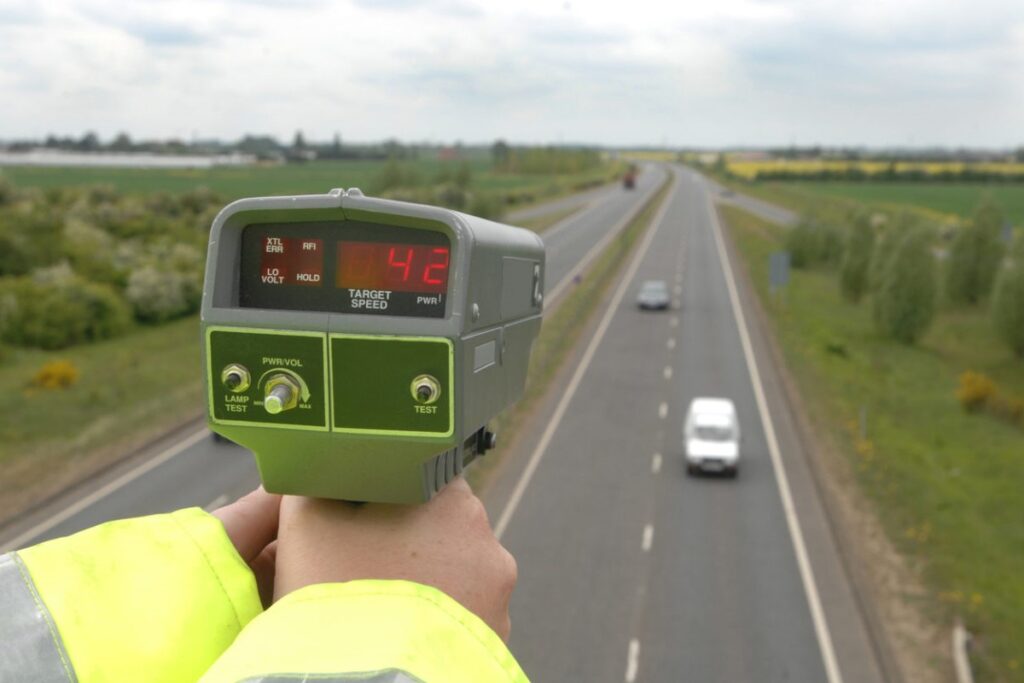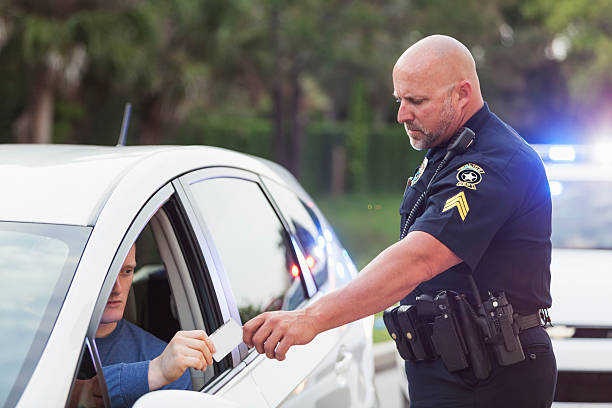Yes, police cars are equipped with radar guns, lidar devices, or other speed detection equipment that allows law enforcement officers to measure the speed of vehicles on the road. When a police car detects a vehicle speeding, they can pursue and pull over the offending vehicle.
The police officer can then issue a citation or ticket to the driver for exceeding the speed limit. Police cars are a common tool used for enforcing traffic laws, including catching speeding motorists.
How do Police Cars Detect Speeding?

These different speed detection technologies provide law enforcement officers with various methods to monitor and enforce speed limits on roads, ensuring better compliance with traffic laws and enhancing road safety.
Radar guns and their functioning
Radar guns are commonly used by law enforcement to detect the speed of vehicles. These devices emit radio waves directed at a moving vehicle and measure the speed of the vehicle by calculating the change in the frequency of the waves reflected back to the radar gun.
This Doppler effect allows the radar gun to determine the speed of the targeted vehicle accurately. Radar guns are effective in detecting speed from a distance and are often mounted inside police cars or held by officers to monitor traffic speed.
Introduction to lidar devices for speed measurement
LIDAR (Light Detection and Ranging) devices are another technology used by police to measure vehicle speed accurately. These devices work by emitting a laser beam directed at a vehicle and measuring the time it takes for the beam to return after bouncing off the vehicle.
Lidar devices can precisely calculate the speed of a specific vehicle and are known for their high accuracy, especially at longer distances. They are handheld or mounted on tripods and are used similarly to radar guns for speed enforcement.
Other speed detection equipment used in police cars
Apart from radar guns and lidar devices, police cars may also be equipped with other speed detection technologies. Some of these include VASCAR (Visual Average Speed Computer and Recorder), which uses two fixed points to calculate the average speed of a vehicle, and pacing, where officers follow a vehicle at a consistent distance and measure its speed by comparing it to their own vehicle’s speedometer.
Additionally, some advanced police vehicles may have automatic license plate recognition (ALPR) systems that can track and record vehicle speeds based on the time it takes to pass between two points.
What is the Process of Catching Speeding Vehicles?

The process of catching speeding vehicles involves a systematic approach that prioritizes safety, communication, and proper documentation to ensure the enforcement of traffic laws while minimizing potential risks during traffic stops.
Initiating a pursuit based on speed detection
Detection of Speeding
Law enforcement officers use radar guns, lidar devices, or other speed detection equipment to identify vehicles exceeding the speed limit.
Decision to Pursue
Upon detecting a speeding vehicle, the officer evaluates whether to initiate a pursuit based on various factors, including road conditions, traffic density, and safety considerations.
Activation of Emergency Equipment
If a pursuit is deemed necessary, the officer activates the police car’s emergency lights and siren to signal the vehicle to stop.
Pulling over the offending vehicle safely
Communication and Signaling
The police officer communicates with the driver through hand signals, the patrol car’s lights, or a loudspeaker, instructing them to pull over safely to the side of the road.
Safety Procedures
The officer considers safety protocols, ensuring that the stop occurs in a well-lit and visible area, away from traffic, to minimize risks for both the officer and the driver.
Approaching the Vehicle
The officer approaches the stopped vehicle cautiously, maintaining situational awareness and following established safety procedures.
Issuing citations or tickets to drivers for exceeding speed limits
Verification of Offense
The officer verifies the details of the speeding violation, including speed recorded by the equipment, and may ask for the driver’s license, vehicle registration, and proof of insurance.
Explanation and Documentation
The officer explains the violation to the driver and may provide documentation, such as a citation or ticket, detailing the offense, the fine amount, and the options for handling the ticket (paying the fine, contesting the citation in court, etc.).
Recording and Reporting
The officer records the details of the traffic stop, including the driver’s information, the offense, and any additional relevant details, which are documented in an official report.
How Accurate are Speed Detection Methods in Police Cars?
factors such as environmental conditions, proper calibration, maintenance, and potential errors in speed measurement can collectively impact the accuracy of speed detection equipment used by law enforcement.
Environmental conditions impacting speed detection accuracy
Weather Conditions
Adverse weather, such as heavy rain, fog, or snow, can affect the accuracy of speed detection equipment by interfering with the transmission and reception of radar or lidar signals.
Terrain and Surroundings
Geographic features like hills, curves, and obstacles on the road may cause signal reflection or obstruction, potentially leading to inaccurate speed readings.
Interference
Electronic interference from nearby sources, such as power lines, other radar devices, or radio frequency signals, can distort speed measurement accuracy.
Calibration and maintenance of speed detection equipment
Regular Calibration
To maintain accuracy, speed detection equipment requires periodic calibration according to manufacturer guidelines. Calibration ensures that the device accurately measures vehicle speeds within specified tolerances.
Proper Maintenance
Routine checks and maintenance of equipment components, including the antenna, lenses, and internal electronics, are crucial to ensure optimal performance and accuracy.
Training for Operators
Proper training for law enforcement officers using speed detection equipment is essential to operate the devices correctly and interpret readings accurately.
Potential errors in speed measurement and their implications
Target Misidentification
Speed detection devices might unintentionally measure the speed of nearby vehicles or stationary objects instead of the intended target, leading to inaccurate readings.
Speed Measurement Variability
Variations in the speed of vehicles within close proximity can sometimes lead to fluctuations in readings, impacting the accuracy of recorded speeds.
Legal Implications
Inaccuracies or errors in speed detection can result in legal challenges from drivers contesting citations, necessitating the need for accurate documentation, calibration records, and expert testimony to support the validity of the speed measurement.
FAQ’s
Do police cars have insurance in the UK?
Yes, police cars in the UK are typically insured by the respective police forces.
Do police officers get their own car in the UK?
In the UK, police officers often use assigned vehicles provided by their police force rather than having their personal cars for duty.
Can police stop your car in the UK?
Yes, the police in the UK have the authority to stop vehicles for various reasons, including routine checks, suspected offenses, or for ensuring road safety.
Do police cars have cameras in the UK?
Many police cars in the UK are equipped with cameras for recording traffic stops, incidents, and for evidentiary purposes.
What do UK police cars carry?
UK police cars often carry essential equipment such as first aid kits, traffic cones, communication devices, and other tools necessary for law enforcement duties.
Do police drive automatic cars in the UK?
Yes, in the UK, police officers often use both manual and automatic transmission cars for their duties, depending on the type of vehicle provided by their police force.
Final Words
In conclusion, police cars play a crucial role in catching speeding motorists using various tools like radar guns and lidar devices. These tools help officers detect speeding by measuring a vehicle’s speed accurately. Once a speeding vehicle is identified, officers initiate a pursuit, ensuring safety while pulling over the vehicle. They then issue citations or tickets to drivers who exceed speed limits, emphasizing the importance of following traffic laws for road safety.
Adhering to speed limits is vital to prevent accidents and ensure everyone’s well-being on the road. The use of police cars equipped with speed detection tools aims to encourage responsible driving behaviors, ultimately contributing to safer roads for all.

